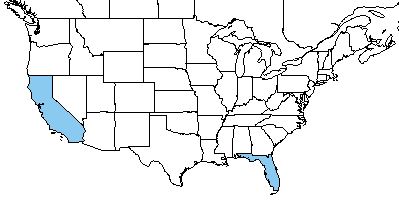Difference between revisions of "Ipomoea triloba"
(→Distribution) |
(→Ecology) |
||
| Line 32: | Line 32: | ||
==Ecology== | ==Ecology== | ||
===Habitat=== <!--Natural communities, human disturbed habitats, topography, hydrology, soils, light, fire regime requirements for removal of competition, etc.--> | ===Habitat=== <!--Natural communities, human disturbed habitats, topography, hydrology, soils, light, fire regime requirements for removal of competition, etc.--> | ||
| + | |||
| + | This species can be found in "hammocks, sand dunes, disturbed areas" <ref name="Weakley> Weakley, A. S. (2015). Flora of the Southern and Mid-Atlantic States. Chapel Hill, NC, University of North Carolina Herbarium. </ref>. | ||
| + | |||
<!--===Phenology===--> <!--Timing off flowering, fruiting, seed dispersal, and environmental triggers. Cite PanFlora website if appropriate: http://www.gilnelson.com/PanFlora/ --> | <!--===Phenology===--> <!--Timing off flowering, fruiting, seed dispersal, and environmental triggers. Cite PanFlora website if appropriate: http://www.gilnelson.com/PanFlora/ --> | ||
<!--===Seed dispersal===--> | <!--===Seed dispersal===--> | ||
Revision as of 15:12, 22 May 2018
| Ipomoea triloba | |
|---|---|

| |
| Photo by John B | |
| Scientific classification | |
| Kingdom: | Plantae |
| Division: | Magnoliophyta - Flowering plants |
| Class: | Magnoliopsida - Dicots |
| Order: | Solanales |
| Family: | Convolvulaceae |
| Genus: | Ipomoea |
| Species: | I. triloba |
| Binomial name | |
| Ipomoea triloba L. | |

| |
| Natural range of Ipomoea triloba from USDA NRCS Plants Database. | |
Contents
Taxonomic Notes
Synonyms: none.
Varieties: none.
Description
I. triloba is a perennial forb or vine. It belongs to the Covolvulaceae family. This species is not native to the continental United States [1].
Distribution
I. triloba is not native to the continental United States, but it has been introduced to California and Florida [1].
Ecology
Habitat
This species can be found in "hammocks, sand dunes, disturbed areas" [2].
Conservation and Management
Cultivation and restoration
Photo Gallery
References and notes
- ↑ 1.0 1.1 USDA Plants Database URL: https://plants.usda.gov/core/profile?symbol=IPTR2
- ↑ Weakley, A. S. (2015). Flora of the Southern and Mid-Atlantic States. Chapel Hill, NC, University of North Carolina Herbarium.